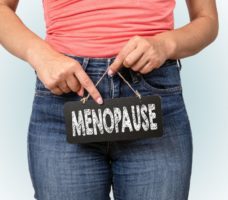Many women have found that yoga, including restorative and supportive poses, can ameliorate the undesirable side effects of menopause, including hot flashes and more.

When Alison, 48, began experiencing intense hot flashes, they often arrived at night and interrupted her sleep. But on the whole, her perimenopausal symptoms were more annoying than unbearable. Then her menstrual cycle spun out of control. “Suddenly, my menstrual flow was really heavy and lasted twice as long as before,” says Alison, who lives in Chicago and requested that her last name not be used. “My periods went on forever.” Her gynecologist suggested that Alison try hormone replacement therapy (HRT), prescription drugs used to control menopausal symptoms. “She told me not to rule it out if my symptoms were really bad, but my feeling was that I’d rather try to just get through them,” Alison says.
She had good reason for wanting to avoid HRT. The treatment regimen, which artificially elevates a woman’s estrogen and progesterone levels, has come under intense scrutiny in recent years. Major studies have linked it to an increased risk of breast cancer, heart disease, strokes, and other life-threatening conditions.
Soon after Alison’s menstrual cycles became so irregular, she went to class at Yoga Circle, her regular studio, and learned an Iyengar asana sequence designed to help women cope with the physical discomforts related to their cycles. Many of the poses were restorative; they included Supta Virasana (Reclining Hero Pose), Supta Baddha Konasana (Reclining Bound Angle Pose), and Janu Sirsasana (Head-of-the-Knee Pose) with the head supported. When Alison’s next menstrual period began, she practiced the sequence every day and noticed that her flow returned to normal. Encouraged by the results, she began to think that she could control her symptoms without HRT. Maybe, she thought, yoga could provide the relief she was looking for. And her intuition proved correct. Many women have found that yoga can ameliorate the undesirable side effects of menopause.
See also Yoga for Menopause: Alleviate Symptoms with Yoga
Yoga for Hormonal Imbalances
Though menopause itself is simply the moment that menstruation stops, the transition generally takes several years. This phase is called perimenopause and typically occurs in women between the ages of 45 and 55. During perimenopause, fluctuating estrogen and progesterone levels can trigger a myriad of uncomfortable symptoms. Among the most common are hot flashes, anxiety and irritability, , , and mood swings, memory lapses, and an erratic menstrual cycle.
Few women experience all of these, but an estimated 55 to 65 percent of them do experience some mild menopause-related problems, says Rowan Chlebowski, MD, of the Harbor UCLA Research and Education Institute in Torrance, California. About 25 percent report almost no disruption to their daily lives, while approximately 10 to 20 percent suffer severe and often debilitating symptoms.
Hormonal fluctuations generally accompany women’s passages into each new biological stage of life; with them often come various discomforts, such as acne and mood swings at puberty, morning sickness during pregnancy, and postpartum depression. “Menopause is no exception,” says Nancy Lonsdorf, MD, author of A Woman’s Best Medicine for Menopause.
Before the onset of perimenopause, a woman’s menstrual cycle is set in motion each month by the hypothalamus, a small structure at the base of the brain that regulates many bodily functions, including appetite and temperature. The hypothalamus signals the pituitary gland to produce important hormones for reproduction, and those hormones in turn stimulate production of estrogen and progesterone in the ovaries. During perimenopause, the ovaries and pituitary gland engage in a kind of tug-of-war. The ovaries decrease hormone production, while the pituitary gland, sensing low hormone levels, continues to spur on the ovaries. This frenetic struggle causes erratic hormonal fluctuations—too much estrogen, which revs the body’s motors, followed by spikes of progesterone, which slows the body.
See also The Best Pose and Acupressure Point to Reduce Bloating
“Hormones are very powerful; they affect just about every tissue of the body,” Lonsdorf says. “So it’s no wonder that various conditions can arise as the body tries to adjust to these hormonal shifts. For instance, when the brain is affected by erratic hormone patterns, sleep, mood, and memory may all be influenced, and when the uterus is stimulated by sporadic hormone patterns, irregular bleeding occurs, and so on.”
Typically, a woman experiences the first signs of this hormonal fluctuation about six years before her menstrual periods end. These symptoms generally continue until a year or more after her last period, when the hormone levels gradually stabilize. After menopause, the ovaries produce less of the female hormones. However, the body still needs some estrogen to keep the bones healthy and to prevent conditions like vaginal dryness. The adrenal glands, which are located above the kidneys, play an important role in this by secreting low levels of male hormones that are converted by fat cells into estrogen. Still, the body must adjust to a new, much lower hormone level.
These natural physiological changes and the havoc they can wreak for many women prompted researchers in the late 1960s to seek a solution for common menopausal symptoms. The treatment they ultimately proposed was HRT. Their reasoning was that problems stemming from declining estrogen levels could simply be eliminated if the missing hormones were replaced. Scientists believed that maintaining hormone levels similar to what the body was used to would provide relief.
See also 12 Yoga Poses to Boost Breast Health
HRT was a simple solution for managing menopausal symptoms. But since several major studies have shown that HRT exposes women to serious health risks, many women have begun seeking more natural solutions. Those who have turned to yoga for relief have found that while asana may not directly influence estrogen production, specific postures can help control unpleasant symptoms. Restorative postures in particular can relax the nervous system and may improve the functioning of the endocrine system (especially the hypothalamus, the pituitary gland, the thyroid, and the parathyroid gland), which helps the body adapt to hormonal fluctuations.

Alleviating the Symptoms of Menopause
Yoga instructor Patricia Walden, 57, knows firsthand how yoga can help temper menopausal complaints. Like many other women’s symptoms, hers arrived like rain: first a sprinkle, then a full-fledged storm. Hot flashes came first, and then—for the next year—she suffered through constant fatigue and insomnia. She often awoke in the night and stayed awake for up to three hours.
On the days when Walden had intense symptoms, she found she needed to modify her yoga routine. She was accustomed to a vigorous daily practice but discovered that unsupported inversions, strenuous poses, and backbends sometimes made her symptoms worse. When that happened, she turned to supported and restorative poses to calm her nerves. She still did inversions, but instead of an unsupported Sirsasana (Headstand), which sometimes brought on more hot flashes, she would do Setu Bandha Sarvangasana (Bridge Pose) using bolsters or Salamba Sarvangasana (Supported Shoulderstand) with a chair. With these modifications, Walden was able to reap the benefits of —relief from anxiety and irritability—without challenging or heating her body.
As Walden’s symptoms diminished, her conviction that yoga could be a potent tool for easing the suffering that accompanies hormonal shifts deepened. She began to connect with other women who were experiencing similar difficulties and has since created specific yoga sequences for women with menopausal symptoms. “I was interested in women’s issues before,” says Walden, co-author with Linda Sparrowe of The Woman’s Book of Yoga and Health: A Lifelong Guide to Wellness. “But after having gone through menopause myself, I am much more sensitive to it.”f
See also Yoga for Women’s Health: The Best Type of Practice for Each Phase of Your Menstrual Cycle
A regular yoga practice can make a world of difference in a woman’s experience of menopause. And a solid practice before this phase can ease the transition, says Suza Francina, author of Yoga and the Wisdom of Menopause. “If you practice yoga before menopause, then all the poses that are especially useful for coping with uncomfortable symptoms are already familiar, and you can reach for them like an old friend,” she says. “If you are familiar with restorative poses, then you have the best menopause medicine at your disposal.”
Yoga Poses for Every Menopause Symptom
Here are descriptions of the most common symptoms and specific recommendations for taming them.
About the Author
Trisha Gura is a freelance science writer and yoga student in Boston. Find her trishagura.com.
This content was originally published here.









